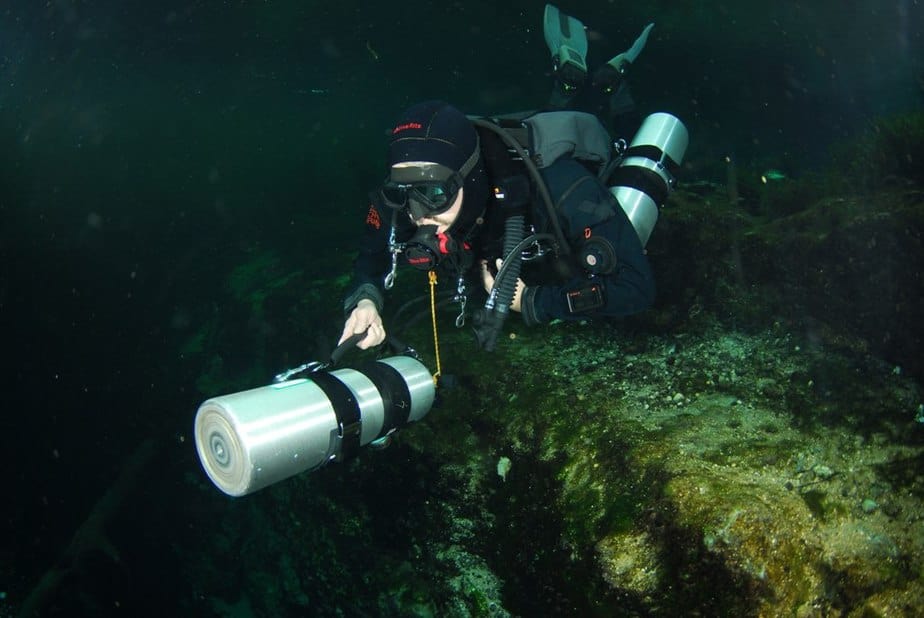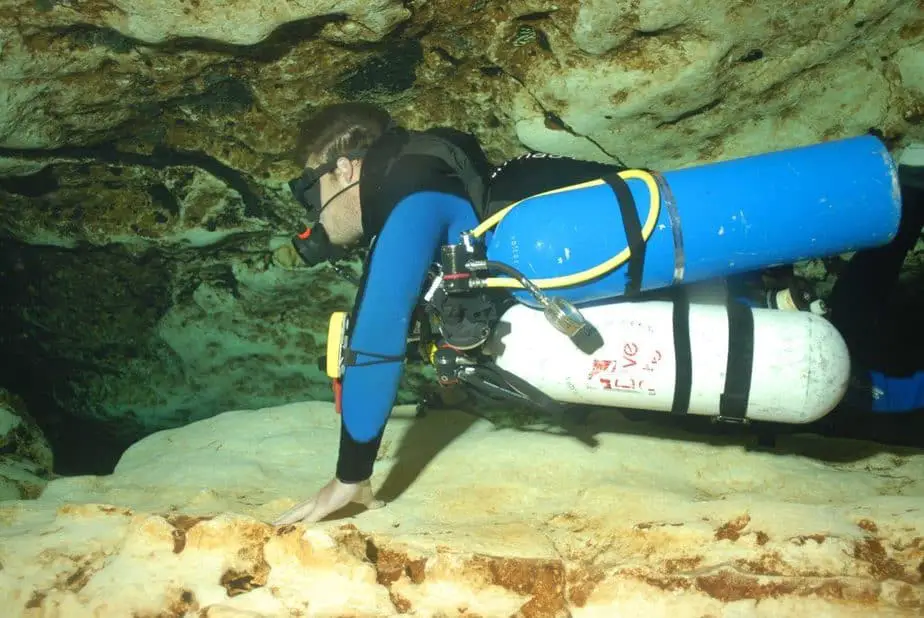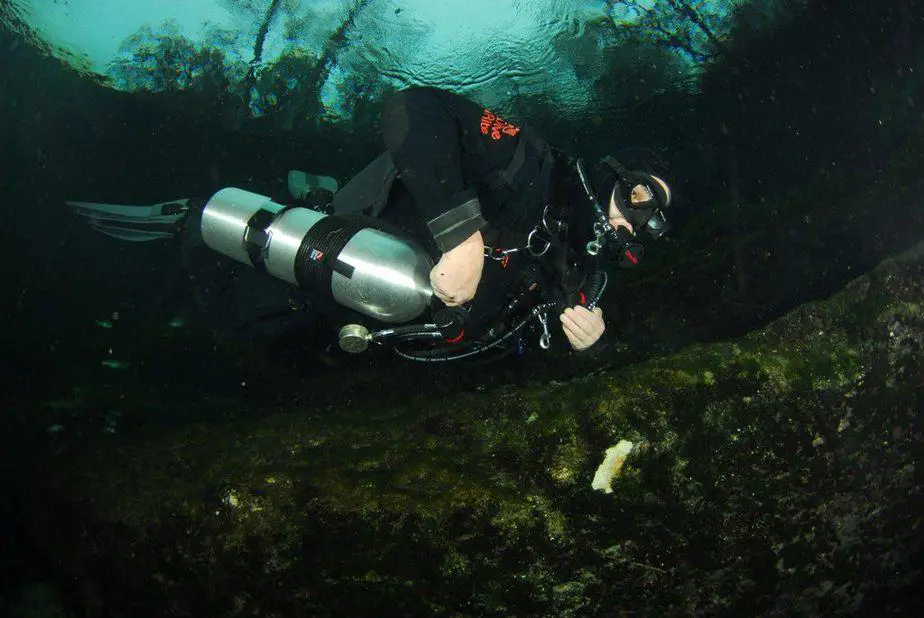If you’re tired of traditional backmounted diving and want to try a new and exciting way of diving, then give sidemount diving a try. A sidemount setup is more streamlined than a backmounted one and allows you to more easily access dive sites like caves and wrecks. With this setup, each kick you make is also more efficient. There are many reasons why you should try sidemount diving, and in order to do so, you must first get yourself a sidemount BCD.
Our Top Picks:
Sidemount BCD Buying Guide
When searching for a sidemount BCD, you have to decide whether you want a hybrid sidemount system or a sidemount only system. Hybrid sidemount systems let you switch between both sidemount and backmount diving. Sidemount only systems are more optimized and therefore provide superior performance for sidemount diving; if you are committed to sidemount diving then this type is the way to go.
In the next section, we have compiled a list of the best sidemount BCDs currently on the market and a brief review of each one. Our selection criteria is determined by features such as single/redundant bladders, wing buoyancy as well as number of and location of LPI/OPV fittings, single-tank cam-band slots, the overall weight and size for travelling divers, buoyancy, and so on. Without further ado, here is our review of the best sidemount BCDs.
Best Sidemount BCDs Review
DiveRite Nomad XT
- Dive Rite Nomad XT Side Mount Rig with Complete Harness System
- TRANSPAC HARNESS available in sizes M, L, XL, XXL.
- WING is available as a single bladder or dual bladder.
- Lift Capacity: 50 lbs (22.6 kg)
- Weight: 9.4 – 10.00 lbs (4.3 – 4.6 kg)
- Type: Hybrid
The DiveRite Nomad XT is a modular hybrid sidemount system that is based on the transpac harness. In other words, it can be quickly converted to both sidemount or backmount use. The wing provides up to 50 lbs of lift capacity and comes in either single or redundant bladder options.
This BCD comes with many features that help to improve your sidemount diving experience. For instance, the Nomad XT’s wing is narrower at the neck area and angled at the sides with greater lift towards the bottom which results in effective sidemount trim.
Next, the low pressure inflator can be found centrally behind the neck, and an additional OPV is included at the bottom. This allows divers to still retain a dump-valve on the lower wing if they swap the LPI to the bottom.
Additionally, a Gusset Control System (GCS) provides divers with greater lift control when swapping out cylinders, for example changing from steel to aluminum, single to twin tanks. Without using either the wing keepers on the waist belt or the Gusset Control System, the Nomad XT can provide a full 50 lbs of lift.
Lastly, when you purchase the DiveRite Nomad XT rig, you will receive a TransPac XT harness, Nomad XT wing, a 2-inch crotch strap and buttplate, loop bungees and chokers, all of which have been assembled together. The only hard work you need to do is to figure out which size you want from M to XXL.
Hollis SMS100
- Lift Capacity: 52 lbs (24 kg)
- Weight: 5 lbs (2.3 kg)
- Type: Hybrid
The Hollis SMS100 is an integrated, hybrid sidemount rig that allows divers to dive the way they want: sidemount or backmount, in single or double tank configurations. It includes an adjustable harness that is reminiscent of a jacket BCD. There is also the option for a deluxe harness design that is very comfortable and available with a single or double bladder.
The SMS100 system from Hollis comes with two cam-bands that divers can use for attaching their sidemount cylinders or used for single tank diving. They can also be bolted directly to backmounted doubles on a soft backplate. Because of its versatility, the Hollis SMS100 is one of the best-selling hybrid sidemount rigs available.
Hollis SMS75
- Trapezoid shape to promote horizontal trim. Adjustable and removable wing bungee
- Designed for cave or open water sidemount. Cam slots for single tank and grommets at 11” for banded doubles
- Reversible Inflator & Dump assembly
- Lift Capacity: 40 lbs (18 kg)
- Weight: 7 lbs (3.2 kg)
- Type: Hybrid
Next up, the Hollis SMS75 is the result of years of development and research after the iconic SMS100. The SMS75 harness differs from the SMS100 in two major ways: it has a more streamlined design for a lower profile, however this comes at the cost of lower maximum buoyancy.
Thus, the SMS75 is catered toward the more hardcore tech, wreck, and cave divers, but is versatile enough to be used in all environments. Divers can operate it effectively for regular, recreational open water diving activities.
In terms of appearance, the SMS75 wing is trapezoidal which helps improve horizontal diving with additional lift towards the hips where it’s sorely needed for sidemount diving. Furthermore, the SMS75 also supports backmounted tanks using cam slots for single tank setups, and grommets at 11” for banded doubles. Lastly, the pull-dump OPV and inflator assembly are reversible between bottom and top positions.
X-Deep Stealth 2.0 TEC and RB
- Lift Capacity: 52 (23.6 kg)
- Weight: 13.2 lbs (6 kg)
- Type: Sidemount Only
X-Deep started a revolution in sidemount diving when they released the original Stealth 2.0 classic, and innovations and advancements in the sidemount diving market have only continued. Three years after the release of their game-changing product, X-Deep have finally come out with something even better: the Stealth 2.0 Tec.
At its base the 2.0 Tec still utilizes the Stealth 2.0 harness and weight management system so that it retains compatibility with all existing Stealth components. After all, if something isn’t broken, why try to fix it? The design has withstood the test of time and remains a market leader.
Where the 2.0 Tec differs is its new wing that provides additional lift and further streamlines the profile. It also has a unique weight system that lets you easily adjust the number of weights you need to achieve neutral buoyancy, even if you are wearing a thick 3mm wet or dry suit with thick undergarments.
Furthermore, since the junction points for this harness are located exactly within the natural axis of the body’s rotation, the shoulder straps will always be the correct length no matter how you move your body underwater. Nothing will limit your range of motion.
Nothing lasts forever, not even the Stealth 2.0 Tec. That is why X-Deep has designed the webbing to be user-replaceable since each of the straps are easy to remove.
Overall, the X-Deep Stealth 2.0 Tec maintains what made the 2.0 classic good and improves upon it so that it can now keep up with the demands of even deeper dives with multi-cylinder setups.
AquaLung Apeks WSX-25 Sidemount Harness System
- Lift Capacity: 27 lbs (12.3 kg)
- Weight: 8.8 lbs (4 kg)
- Type: Sidemount Only
The Apeks WSX-25 harness, also released after 3 years of continuous development, is very impressive. It takes the best characteristics of the top sidemount harnesses and combines them into a practical and aesthetic rig. Several sidemount instructors and enthusiasts have used the WSX-25 on hundreds of dives with wetsuits, drysuits, with multiple stages and with various cylinders, and they found it has kept up with everything thrown its way.
Thanks to its durable construction, the WSX-25 can take a beating. It is made from Armoguard, a robust material that is used in military and public safety diving products. If you thought Cordura (the most commonly used material in scuba BCDs) was strong, wait until you find out Armoguard is 10x more abrasion resistant. It is highly unlikely the wing is going to get punctured or torn open any time soon.
The WSX-25 is also highly optimized and makes sidemount diving more convenient. It features a reversible inflator and dump valve that can be mounted on either the left or right hand side, as well as a centre flush dump valve for ambidextrous diving.
Next, Apeks have created their “SlideLock” sliding D-ring which allows divers to quickly adjust the position of their cylinders as their buoyancy changes over the course of the dive. There’s no need to clip your cylinder(s) on and off, just reposition the D-rings during the dive. The bladder also technically has a lift capacity of 27 lbs even though in the manual it states 25.
Though this system was designed with sidemount cave diving in mind, since every diver should have a horizontal profile for the purposes of better buoyancy control, relaxation, and anti-silting, the WSX-25 is suitable for any diver. Whether you plan on sidemounting single or twin cylinders and all of the stages required, the WSX-25 can handle any environment from open water to caves and wrecks.
Frequently Asked Questions
Should I use a “sidemount only” or hybrid sidemount system?
There are two major types of sidemount systems available on the market. They can be categorized as “Sidemount Only” systems or “Multi-Use Sidemount Systems”. As the name implies, sidemount-only systems allow diving only in sidemount, whereas multi-use or hybrid systems allow sidemount and backmount configurations.
Over the last decade or so, sidemount-only systems are becoming more and more popular. With that said, which system you decide to use depends on your own preferences. Hybrid systems are obviously more versatile and allow you to dive in multiple ways. However, a sidemount-only system utilizes a custom fit harness which means it is compatible with all body sizes and shapes, which is not always possible with a hybrid system.
Furthermore, multi-use systems tend to provide lift high up on the diver’s body, which affects trim and makes it difficult to weight and balance. On the other hand, sidemount-only systems provide lift at the hip area which is a more balanced and optimal location.
There is also the matter of hose routing. Whether you get a sidemount or hybrid system, you should route the hoses behind your head and keep your chest area clear so access to life support equipment remains unobstructed.
What are the benefits of using a sidemount BCD?
There are many benefits to sidemount diving. For one, it is more hydrodynamic than traditional backmounted diving. In other words, by going sidemount, you can reap the following benefits:
- More buoyancy control due to a more streamlined setup.
- Efficient glide and propulsion from every kick thanks to the streamlined setup.
- Greater comfort since your spine is not encumbered by the cylinders.
- Easier to operate your BCD inflator and deflator.
- Better safety overall and comfort due to the extra redundancy in a sidemount setup.
Having a more streamlined sidemount setup does so much for your diving experience in ways you may not realize. For instance, now more dive sites are accessible, particularly cave or wreck diving where you do not want any overhead. Furthermore, challenging conditions like long swims and currents are easier to brave. However, in order to save the most energy, you could also rely on an underwater scooter to help you out.
Furthermore, most sidemount harnesses are custom fit, meaning all body shapes and sizes are compatible. This provides greater comfort and proper fitting for all individuals, particularly for women. In fact, for many ladies, technical diving is possible only with a sidemount setup!
There are many reasons why you should give sidemount BCDs a try, and the reasons listed above only scratch the surface.
Do you have to dive with two cylinders in a sidemount setup?
A common misconception divers have about sidemount diving is that it can only be done with two cylinders. No! While equipment overload is a very valid concern, you can dive with only one cylinder in sidemount and it is, in fact, a great way to dive.
The common reactions first time sidemount divers have when they try sidemount single cylinder diving is that they really enjoy the freedom. Diving without a cylinder on their back feels very liberating, and most divers quickly realize that adding a 2nd cylinder is not much different from single cylinder sidemount diving except it is now even easier to get proper balance and trim.
Best Sidemount BCD Review: Parting Words
In order to get started with sidemount diving, you should first find a sidemount instructor to teach you the basics. Many divers try sidemount diving with inadequate training and eventually give up and swear off sidemount diving forever.
Unfortunately, looking up an instructor on YouTube isn’t enough; ideally you should take a course that lasts 3-4 days minimum with at most 2 other students. This way, you have ample time and attention from the instructor to give you personalized advice. Your sidemount instructor will also help you with setting up your gear and ensuring you are doing things correctly.
When searching for a sidemount instructor, make sure you are properly vetting them. Research the kinds of courses they are offering, how long they have been specifically sidemount diving, and whether they actually believe in the benefits of sidemount diving or if they are just trying to take your money.
Even if you are using the best sidemount BCD, it is just a tool, and in the hands of an experienced diver it may not be used to its full potential. With a sidemount BCD, you can take advantage of a more streamlined setup and save your back from a lot of aches.
Photo Credits:
-
- Pete Nawrocky, CC BY-SA 3.0, via Wikimedia Commons
- Pete Nawrocky, CC BY-SA 3.0, via Wikimedia Commons
- Pete Nawrocky, CC BY-SA 3.0, via Wikimedia Commons
Last update on 2025-06-29 / Affiliate links / Images from Amazon Product Advertising API





